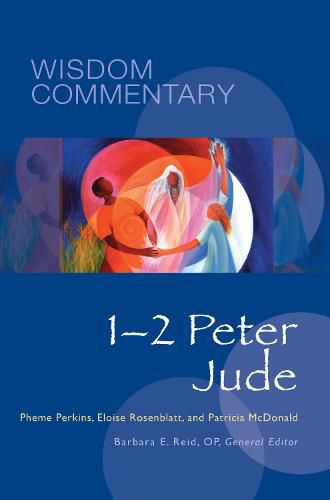Readings Newsletter
Become a Readings Member to make your shopping experience even easier.
Sign in or sign up for free!
You’re not far away from qualifying for FREE standard shipping within Australia
You’ve qualified for FREE standard shipping within Australia
The cart is loading…






This title is printed to order. This book may have been self-published. If so, we cannot guarantee the quality of the content. In the main most books will have gone through the editing process however some may not. We therefore suggest that you be aware of this before ordering this book. If in doubt check either the author or publisher’s details as we are unable to accept any returns unless they are faulty. Please contact us if you have any questions.
Reading 1 Peter through the lens of feminist and diaspora studies keeps front and center the bodily, psychological, and social suffering experienced by those without stable support of family or homeland, whether they were economic migrants or descendants of those enslaved by Roman armies. In the new household of God, believers are encouraged to exhibit a moral superiority to the society that engulfs them. But adoption of elite values cannot erase the undertones of randomized verbal abuse, general scorn, and physical violence that women, immigrants, slaves, and freedmen faced as the facts of life.
First Peter offers the honor of identifying with the Crucified, by his bruises you are healed (2:24). A Christian liberation ethic would challenge 1 Peter’s approach.
Pliny the Younger, governor of Bithynia-Pontus in north-western Asia Minor, is a contemporary of 2 Peter’s writer. The polemical, accusatory genre of 2 Peter, like Jude, originates in Roman judicial rhetoric. The pastor, in the persona of a prosecuting attorney, condemns immoral defendants, including influential women. Their crimes encode community tensions over women’s leadership, Gentile-members’ sexual ethics, their syncretistic deviations from Jewish doctrine on creation, and the certainty of divine judgment and punishment. Citations to Elizabeth Cady Stanton’s A Woman’s Bible enliven the commentary. The doctrinal disorder prompts the male pastor to sustain loyalists in their commitment to Our Lord and Savior Jesus Christ. Second Peter dramatizes an ecclesial crisis whose solution was the eventual imposition of a magisterium to silence dissent.
Brief, combative, and assuming a familiarity with a literary culture that most twenty-first-century readers do not have, the Letter of Jude would be an obvious candidate for being the most neglected book of the New Testament. As a model for a pastoral strategy, it can be recommended only with great reservations: almost everyone will find in it something problematic, if not offensive. Yet, in addition to giving a window on a Greek-speaking Jewish-Christian milieu, Jude’s energetic prose testifies to the author’s visceral concern for those attempting to live by the gospel in difficult circumstances. Furthermore, to the extent that over familiarity with parts of the New Testament can blunt their challenge, this letter provides a salutary reminder that the entire canon originated in a world that is radically unfamiliar to us.
$9.00 standard shipping within Australia
FREE standard shipping within Australia for orders over $100.00
Express & International shipping calculated at checkout
This title is printed to order. This book may have been self-published. If so, we cannot guarantee the quality of the content. In the main most books will have gone through the editing process however some may not. We therefore suggest that you be aware of this before ordering this book. If in doubt check either the author or publisher’s details as we are unable to accept any returns unless they are faulty. Please contact us if you have any questions.
Reading 1 Peter through the lens of feminist and diaspora studies keeps front and center the bodily, psychological, and social suffering experienced by those without stable support of family or homeland, whether they were economic migrants or descendants of those enslaved by Roman armies. In the new household of God, believers are encouraged to exhibit a moral superiority to the society that engulfs them. But adoption of elite values cannot erase the undertones of randomized verbal abuse, general scorn, and physical violence that women, immigrants, slaves, and freedmen faced as the facts of life.
First Peter offers the honor of identifying with the Crucified, by his bruises you are healed (2:24). A Christian liberation ethic would challenge 1 Peter’s approach.
Pliny the Younger, governor of Bithynia-Pontus in north-western Asia Minor, is a contemporary of 2 Peter’s writer. The polemical, accusatory genre of 2 Peter, like Jude, originates in Roman judicial rhetoric. The pastor, in the persona of a prosecuting attorney, condemns immoral defendants, including influential women. Their crimes encode community tensions over women’s leadership, Gentile-members’ sexual ethics, their syncretistic deviations from Jewish doctrine on creation, and the certainty of divine judgment and punishment. Citations to Elizabeth Cady Stanton’s A Woman’s Bible enliven the commentary. The doctrinal disorder prompts the male pastor to sustain loyalists in their commitment to Our Lord and Savior Jesus Christ. Second Peter dramatizes an ecclesial crisis whose solution was the eventual imposition of a magisterium to silence dissent.
Brief, combative, and assuming a familiarity with a literary culture that most twenty-first-century readers do not have, the Letter of Jude would be an obvious candidate for being the most neglected book of the New Testament. As a model for a pastoral strategy, it can be recommended only with great reservations: almost everyone will find in it something problematic, if not offensive. Yet, in addition to giving a window on a Greek-speaking Jewish-Christian milieu, Jude’s energetic prose testifies to the author’s visceral concern for those attempting to live by the gospel in difficult circumstances. Furthermore, to the extent that over familiarity with parts of the New Testament can blunt their challenge, this letter provides a salutary reminder that the entire canon originated in a world that is radically unfamiliar to us.